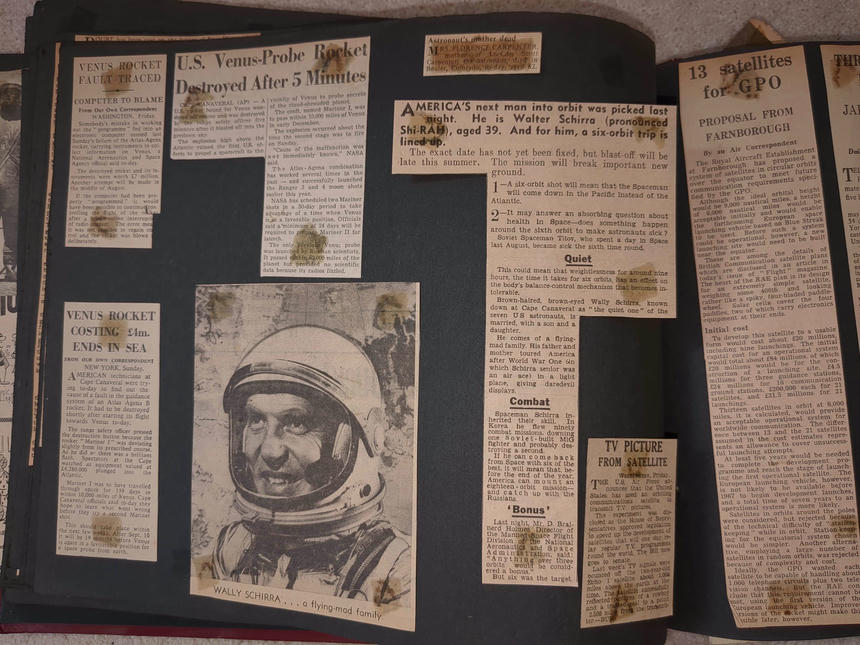Scrapbook 2: Jul 1962 — Mariner, Wally Schirra

VENUS ROCKET FAULT TRACED
COMPUTER TO BLAME
From Our Own Correspondent WASHINGTON, Friday.
Somebody’s mistake in working out the “programme” fed into an electronic computer caused last Sunday’s failure of the Atlas-Agena rocket, carrying instruments to collect information on Venus, a National Aeronautics and Space Agency official said to-day.
The destroyed rocket and its instruments were worth £7 million. Another attempt will be made in the middle of August.
If the computer had been properly “programmed” it would have been possible to continue controlling the flight of the rocket after a brief routine interruption of radio contact. The error meant it was not possible to regain control and the rocket was blown up deliberately.
U.S. Venus-Probe Rocket Destroyed After 5 Minutes
CAPE CANAVERAL (AP)—A U.S. rocket bound for Venus wandered off course and was destroyed by the range safety officer five minutes after it blasted off into the predawn sky.
The explosion high above the Atlantic ruined the first U.S. efforts to propel a spacecraft to the vicinity of Venus to probe secrets of the cloud-shrouded planet.
The craft, named Mariner I, was to pass within 10,000 miles of Venus in early December.
The explosion occurred about the time the second stage was to fire on Sunday.
“Cause of the malfunction was not immediately known,” NASA said.
The Atlas-Agena combination has worked several times in the past — and successfully launched the Ranger 3 and 4 moon shots earlier this year.
NASA has scheduled two Mariner shots in a 50-day period to take advantage of a time when Venus is in a favorable position. Officials said a minimum of 24 days will be required to prepare Mariner II for launch.
The only previous Venus probe was launched by Russian scientists. It passed within 62,000 miles of the planet but provided no scientific data because its radios fizzled.
VENUS ROCKET COSTING £4m. ENDS IN SEA
FROM OUR OWN CORRESPONDENT NEW YORK, Sunday.
AMERICAN technicians at Cape Canaveral were trying to-day to find out the cause of a fault in the guidance system of an Atlas Agena B rocket. It had to be destroyed shortly after starting its flight towards Venus to-day.
The range safety officer pressed the destruction button because the rocket “Mariner I” was deviating slightly from its prescribed course. As he did so there was a brilliant flash. Spectators at the Cape watched as equipment valued at £4,280,000 plunged into the Atlantic.
Mariner I was to have travelled through space for 139 days to within 10,000 miles of Venus. Cape Canaveral officials said to-day they hope to learn what went wrong before they try a second Mariner shot.
This should take place within the next few weeks. After Sept. 10 it will be 19 months before Venus is again in a favourable position for a space probe from earth.
Astronaut’s mother dead
MRS. FLORENCE CARPENTER, mother of Lt.-Cdr. Scott Carpenter, the astronaut, died in Bouler, Colorado, to-day, aged 62.
AMERICA’S next man into orbit was picked last night. He is Walter Schirra (pronounced Shi-RAH), aged 39. And for him, a six-orbit trip is lined up.
The exact date has not yet been fixed, but blast-off will be late this summer. The mission will break important new ground.
1—A six-orbit shot will mean that the Spaceman will come down in the Pacific instead of the Atlantic.
2—It may answer an absorbing question about health in Space—does something happen around the sixth orbit to make astronauts sick?
Soviet Spaceman Titov, who spent a day in Space last August, became sick the sixth time round.
Quiet
This could mean that weightlessness for around nine hours, the time it takes for six orbits, has an effect on the body’s balance-control mechanism that becomes intolerable.
Brown-haired, brown-eyed Wally Schirra, known down at Cape Canaveral as “the quiet one” of the seven US astronauts, is married, with a son and a daughter.
He comes of a flying-mad family. His father and mother toured America after World War One (in which Schirra senior was an air ace) in a light plane, giving daredevil displays.
Combat
Spaceman Schirra inherited their skill. In Korea he flew ninety combat missions, downing one Soviet-built MiG fighter and probably destroying a second.
If he can come back from Space with six of the best, it will mean that, before the end of the year, America can mount an eighteen-orbit mission—and catch up with the Russians.
‘Bonus’
Last night, Mr. D. Brainerd Holmes, Director of the Manned Space Flight Division of the National Aeronautics and Space Administration, said: “Anything over three orbits would be considered a bonus.”
But six was the target.
TV PICTURE FROM SATELLITE
WASHINGTON, Friday.
THE U.S. Air Force announces that the United States has used an orbiting communications satellite to transmit T.V. pictures.
The experiment was disclosed as the House of Representatives approved legislation to speed up the development of satellites that will one day relay regular T.V. programmes round the world. The Bill now goes to senate.
Last week’s TV signals were bounced off the two-year-old Echo 1 satellite about 1,000 miles above the earth at the time. The satellite successfully reflected pictures of a cowboy and a trained seal to a point 2,500 miles from the transmitter.—BUP.